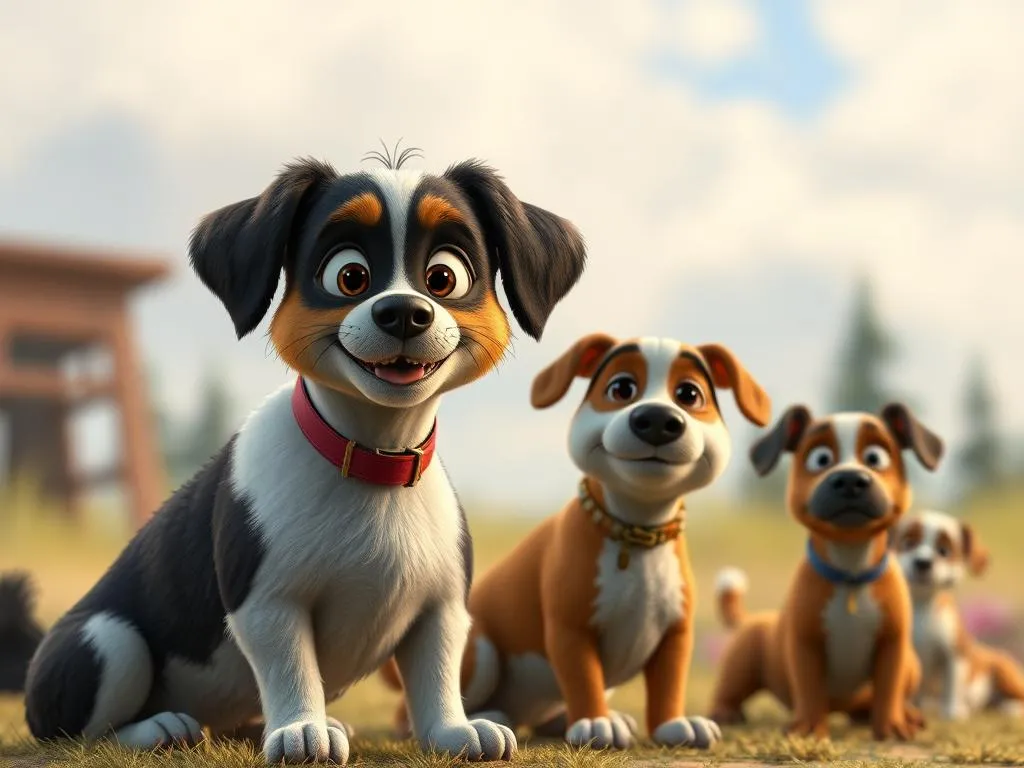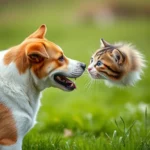
Introduction
Dogs have long held a cherished position in the hearts of audiences around the world, and their presence in animated films underscores this affection. These lovable canines often serve as symbols of loyalty, friendship, and adventure, making them integral to many beloved stories. From whimsical sidekicks to heroic protagonists, dogs in animated films not only entertain but also resonate emotionally with viewers, creating a profound cultural connection.
This article will explore the portrayal of dogs as crucial characters in animated storytelling, examining their evolution, significance, and the impact they have on audiences of all ages. Understanding the role of these animated dogs reveals much about our collective values, emotions, and the narratives that captivate us.
The Role of Dogs in Animated Films
Historical Overview
The portrayal of dogs in animated films can be traced back to the early days of animation. Characters like Snoopy from the Peanuts franchise and Pluto from Disney have laid the groundwork for how dogs are depicted in animated storytelling. These characters have not only entertained generations but have also evolved with the medium, reflecting societal changes and technological advancements.
As animation technology progressed, the depictions of dogs became more intricate and relatable. Iconic films such as Lady and the Tramp and 101 Dalmatians showcased dogs as central figures in the narrative, illustrating their importance in storytelling. Today, characters like Dug from Up and Bolt demonstrate how far the animation industry has come in creating realistic and emotionally resonant canine characters.
Types of Roles Played by Dogs
Dogs in animated films can be categorized into several roles that contribute significantly to the narrative:
-
Sidekicks: These loyal companions often provide comic relief and support to the main characters. For instance, Scooby-Doo exemplifies this role, assisting his human friends in solving mysteries while adding humor and charm.
-
Protagonists: In some films, dogs take center stage as the main characters. Lady and the Tramp tells the love story of two dogs from vastly different backgrounds, showcasing their journey and the challenges they face together.
-
Antagonists: Not all dogs are portrayed as heroes. Some animated films feature dogs in villainous roles, such as the Beast in Beauty and the Beast, who initially appears monstrous but ultimately reveals a deeper story.
Common Themes Associated with Dogs
Dogs in animated films often embody themes that resonate deeply with audiences:
-
Loyalty and Friendship: The bond between dogs and humans is a recurring motif, illustrating the unconditional love and fidelity that dogs provide.
-
Adventure and Exploration: Many animated films showcase dogs embarking on thrilling adventures, often leading to personal growth and discovery.
-
Overcoming Adversity: Dogs are frequently depicted as characters who face challenges, whether it be navigating a new environment or overcoming personal fears, reflecting resilience and courage.
Iconic Dogs in Animated Films
Classic Animated Dogs
Several classic characters have left an indelible mark on animated history:
-
Snoopy: As Charlie Brown’s imaginative beagle, Snoopy’s whimsical adventures and alter egos have made him a timeless icon.
-
Pluto: Disney’s lovable pet, Pluto, has been a staple character since his debut in the 1930s, showcasing a unique blend of humor and loyalty.
-
Brian Griffin: From Family Guy, Brian is a sophisticated dog who engages in human-like conversations, challenging the typical portrayal of dogs in animation.
These characters not only entertain but also embody the traits that make dogs so beloved.
Modern Animated Dogs
As technology has evolved, so too have the portrayals of dogs in animated films:
-
Bolt: This character from Disney’s Bolt is a dog who believes he possesses superpowers. His journey of self-discovery and friendship resonates with audiences of all ages.
-
Dug: Featured in Up, Dug is a golden retriever equipped with a collar that allows him to speak. His innocent nature and loyalty to his owner add depth to the film’s emotional core.
Modern animation techniques, including CGI, have allowed for more realistic and expressive portrayals of dogs, enhancing their relatability and appeal.
Dogs Across Different Cultures
The depiction of dogs in animated films varies across cultures. In Western animation, dogs are often portrayed as loyal companions and heroes. In contrast, Japanese anime may depict dogs with a broader range of characteristics, sometimes highlighting their mystical or spiritual significance.
Notable international films featuring dogs, such as A Dog’s Purpose (American) or The Dog of Flanders (Belgian), showcase the diverse storytelling approaches to canine characters, reflecting cultural values and beliefs.
The Impact of Dogs on Audience Engagement
Emotional Connection
One of the most powerful aspects of dogs in animated films is their ability to evoke emotional responses. Dogs embody loyalty, love, and companionship, themes that resonate with viewers. The portrayal of dogs overcoming challenges or experiencing loss can lead to poignant moments that resonate deeply, often leaving lasting impressions.
For instance, the emotional journey of Dug in Up touches on themes of belonging and unconditional love, making it a memorable experience for audiences.
Audience Demographics
Dogs in animated films appeal to a wide demographic, from young children to adults. Families often bond over these films, as the stories resonate with shared experiences of love and friendship. Children are particularly drawn to animated dogs, often identifying with their adventures and emotions.
The universal traits of dogs—loyalty, bravery, and playfulness—ensure that they remain endearing characters regardless of age.
Marketing and Merchandise
The popularity of dogs in animated films has significant implications for marketing and merchandise. Characters like Snoopy and Bolt have spawned a plethora of toys, clothing, and other merchandise, generating substantial revenue for their franchises.
Studios recognize the commercial potential of animated dogs, often leveraging their popularity in marketing campaigns. The success of dog-related franchises highlights how these characters can transcend the screen to become cultural symbols.
Behind the Scenes: Creating Animated Dogs
Animation Techniques
The creation of memorable dog characters involves various animation techniques. Traditional 2D animation, as seen in classic films, relies on hand-drawn artistry, while modern 3D animation utilizes computer-generated imagery to create lifelike movements and expressions.
Studios like Pixar and Disney are renowned for their innovative approaches to animation, pushing the boundaries of how dogs are portrayed on screen. The ability to create realistic fur, expressive eyes, and fluid movements has enhanced the effectiveness of animated storytelling.
Voice Acting
Voice actors play a crucial role in bringing animated dogs to life. The right voice can imbue a character with personality and charm, making them more relatable. For example, John Goodman as Pongo in 101 Dalmatians lends a warm, endearing quality to the character, enhancing the emotional connection with the audience.
The collaboration between animators and voice actors is vital in crafting compelling dog characters that resonate with viewers.
Character Design
Character design is another critical aspect of creating dogs in animated films. Designers consider various factors, such as breed characteristics, personality traits, and the intended narrative. For instance, a mischievous dog might have exaggerated features to emphasize their playful nature, while a heroic dog might have a more noble appearance.
The design process ensures that each dog character is unique and embodies the traits that make them appealing to audiences.
The Future of Dogs in Animated Films
Trends in Animation
As animation continues to evolve, new trends may influence how dogs in animated films are portrayed. The rise of CGI has opened up new possibilities for creating realistic dog characters, allowing for more nuanced storytelling.
Emerging technologies, such as virtual reality and augmented reality, may also offer innovative ways to engage audiences with animated dogs, enhancing the overall viewing experience.
Potential Storylines and Themes
Future films could explore diverse storylines and themes involving dogs in animated films. There is potential for narratives that showcase mixed breeds, different sizes, and unique backgrounds, reflecting the diversity of dog ownership today.
Additionally, themes like environmentalism, social issues, and interspecies friendships could provide fresh perspectives on the roles of dogs in animated storytelling.
Audience Expectations
As audiences become more discerning, their expectations for dogs in animated films are evolving. Viewers increasingly seek depth in character development and storytelling, prompting creators to craft more complex and relatable dog characters.
Social media also plays a significant role in shaping the perception of animated dogs, allowing fans to share their thoughts and engage with the content in ways previously unimaginable.
Conclusion
In summary, dogs in animated films hold a special place in our hearts, serving as symbols of loyalty, adventure, and friendship. From classic characters like Snoopy to modern portrayals such as Dug, these animated canines have shaped our cultural landscape and continue to resonate with audiences around the world.
As we look to the future, the potential for new storylines, innovative animation techniques, and evolving audience expectations promises to keep the legacy of animated dogs alive and thriving. Whether they are sidekicks, protagonists, or even antagonists, the impact of these characters on storytelling is undeniable, ensuring that they will remain beloved fixtures in the world of animation for generations to come.









